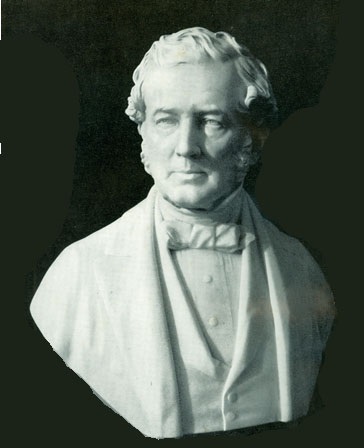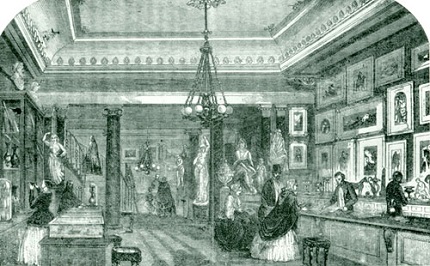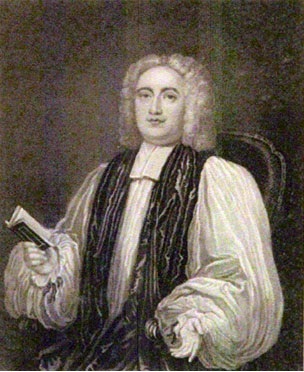
| Print | Back |  |
October 20, 2014 |
 |
Moments in Art Pontiff of Past and Futureby Lawrence Jeppson |
The art business of Vittorio Zanetti and Thomas Agnew was prospering.
Even so, in Lancashire all was not heaven. The great majority of English working class were employed under old conditions of life, and in Manchester — Peterloo to be more precise — the yeomen, sabers flashing, swept down and massacred protesting factory hands.
The Corn Laws were both a problem and a symptom of turmoiling England. When war with France broke out in 1792, the price of wheat in Britain sat at 43 shillings a quarter (8 bushels). But as the grain fields of first France then other countries on the continent became cut off, prices spiraled.
And by 1812, when England was also fighting America and Napoleon was on his way toward Moscow, the gyrating price escalated to 126 shillings.
Tenant farmers, freehold yeomen, and recipients of tithes and rents off land profited, but the price of bread became an onerous burden for the poor. Lucrative wheat prices induced farmers to plow up new lands and plant wheat. With peace came a grain glut and a drop in prices, which was devastating.
In 1815, Parliament passed the emergency Corn Law to save the farmer. This and subsequent Corn Laws were supposed to keep grain prices high and vitiate some of the suffering of the farm folk at the expense of everyone else.
Conditions became especially bad in the south, where the hired farmer was farthest from wage-paying factories that would have paid him better, and too often was forced "to take part of his wages in bad corn and worse beer.” Protesters marching in 1830 were hanged or shipped off to Australia.
But for Thomas Agnew everything fell nicely into place. In 1823 he married Jane Lockett, whose wealthy father became his financial backer and social mentor. The couple's first son, William, the second important Agnew, was born in 1825, the same year Thomas had his own portrait painted by S. W. Reynolds.
In 1826, the business had so prospered that it needed to move to larger quarters on Exchange Street — where it remained for 106 years. (It would later move to London.) To reduce inventory before moving, 64 paintings were put up for auction. The sale lasted nine days.
In 1827, Thomas purchased a picture of St. Paul's by George Vincent at the Lord de Tabley sale at Christie's; since that time no other client was remotely so important to that venerable auction house.
And Thomas, though he had described himself as a carver and gilder in the 1821 Manchester Directory, was pushing the company's print business at a pace that outran anything Zanetti had ever dared alone.
In 1828, the dizzied Zanetti forsook it all and retired to a small estate he had purchased on the Isola dei Pescatori, Lago Maggiore. Provision had been made for the old man's son, Joseph, to become a partner in the business, which changed from Zanetti and Agnew to Agnew and Zanetti. By 1835, however, Joseph had disappeared, and only the Thos. Agnew name survived.
Once the elder Zanetti was gone off to Italy for the last time, Thomas was freed to employ everything he had learned in 18 years. For one thing, Thomas had been honing his own eye. He must have recognized that many of the old masters brought in from the continent by Zanetti were, to say it nicely, of overambitious attribution.
Thomas had started to make his own jaunts across the channel to see and buy pictures, and he asked John Smith, a London dealer with whom he completed many transactions, for his Catalog Raisonné of Dutch paintings.
The ugliness that British manufacturers were spreading across Lancashire was spawning great masses of wealth. Britain was in the throes of change. Factory hands and miners were still outnumbered by agricultural workers (whom the Corn Laws were supposed to protect) and industrial workers in small workshops.
Also, unbelievably, there were half again as many female domestic servants in England as all the men, women, and children combined working in the burgeoning cotton industry. But these ratios were reversing.
The ever-richer industrial barons faced virtually no regulation, paid negligible taxes, and were free to indulge their tastes. Some of them, if they threw ugly structures across the public landscape, were more than willing to counterbalance this privately through purchases of agreeable pictures.
Various PBS television shows, historical and fictional, show us remnants of these years.
French novelist Stendhal gloomily wrote in his diary in 1829, "Democracy will give the death blow to the fine arts; the princes will buy no more pictures but invest their money in America so that in the event of their fall they will be wealthy commoners; rich people who lack that finer culture essential to the appreciation of art will penetrate into the salons."
Stendhal did not understand that across the channel the English nouveau riche would opt for the nobles' hobbies. Art collecting passed from landed gentry to brewers, merchants, textile magnates, bankers. Agnew slaked their thirst for old masters.
These new rich were Englishmen growing rich on English sweat and English products. And England’s colonies. Zanetti’s heart was on the continent; Thomas Agnew's was not, and it is hard to say who pushed whom harder — Thomas or his Manchester clients — but before long Thomas Agnew's business in old masters was overtaken by Thomas Agnew's business in contemporary English art.
Though he did not see himself as such, he was a prophet of the future as well as a pontiff of the past.
Says Geoffrey Agnew, whom I knew in London, of his great-great grandfather: “A dealer can seldom afford to initiate taste, but a dealer with flair can anticipate the circumstances in which taste changes and by doing so accelerate that change.” [Agnew’s, 1817-1967]
Among English painters of the time, Thomas met and admired young Richard Parkes Bonington. But Bonington was soon dead, and what the two men might have done together rests to conjecture.
There were two other great painters active in England: John Constable (1776-1837) and William Turner (1775-1850), but just how soon Thomas began selling them we cannot tell, for his oldest extant stock book which identifies pictures individually dates from 1850.
Except for these two and Sir Henry Raeburn (1756-1823), who was really of an earlier generation, England of the 19th century was devoid of great painters; yet it was filled with popular painters of sufficient derivative skill that English tastes could be fulfilled, and Thomas Agnew carried on a spritely trade of works by a bevy of English painters, none of them exactly household words today.
To fill in his time, Thomas and his father-in-law became active in politics, and Thomas was elected to several public offices. As mayor of Salford in 1851, Thomas received Queen Victoria.

By publishing engravings, Agnew spread his name far and wide throughout England and, indeed, on the continent. He was a founding member of the Printseller’s Association and later served as its president for many years.

Agnew's engravings were wholesaled to other dealers, even to Colnaghi, Agnew’s long-time London rival. In 1847 Belgian Ernest Gamhart, who occupied houses in Paris, London, and Bruxelles, owed Thomas nearly £1,000 just for prints.
In 1850, Arthur Fitzwilliam Tait, who had started with Agnew in 1831 at 12, left to become an artist for America's fabled printmakers, Currier and lves.
By the time Agnew’s was granted a Royal Warrant by Queen Victoria in 1850, the art dealer had reached the forefront, and until World War I this leadership was not relinquished. A Catalog of Publications issued in 1907 stated, "In Messrs. Agnew's portfolios will generally be found impressions of every Engraving, English and Foreign, of acknowledged character and quality, published during the last 100 years.”
Thomas himself published more than 1000 subjects.
During Agnew's first decade, the majority of the prints published were portraits: men of affairs in Manchester, doctors, clergymen, inventors, and political candidates. Other editors had a tight hold on sporting subjects, and so, with a few exceptions, Agnew left this market idle.

Political events offered Agnew the richest potential. A picture with 50 faces had at least a hundred times the chance for commercial success as a simple portrait. Not only would each person depicted wish a print, but so would many of his friends and family — and all the partisans to the viewpoint of the group portrayed.
Prints were the eye on history, much as photojournalism magazines and television later became.
One of the most successful engravings was a print of Richard Ansdell's very large picture Country Meeting of the Royal Agricultural Society, 1843 showing 81 distinguishable persons. A recent scholar in England, Dongho Chun, counted 121 figures, but this probably included individuals who could not be identified.
Four years later J. R. Herbert painted The Meeting of the Anti-Corn Law League: 58 persons, including two shown as framed portraits on the wall, are identifiable in the etching.
Prints like that were big moneymakers.
| Copyright © 2024 by Lawrence Jeppson | Printed from NauvooTimes.com |